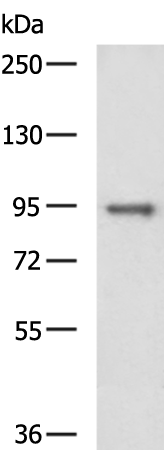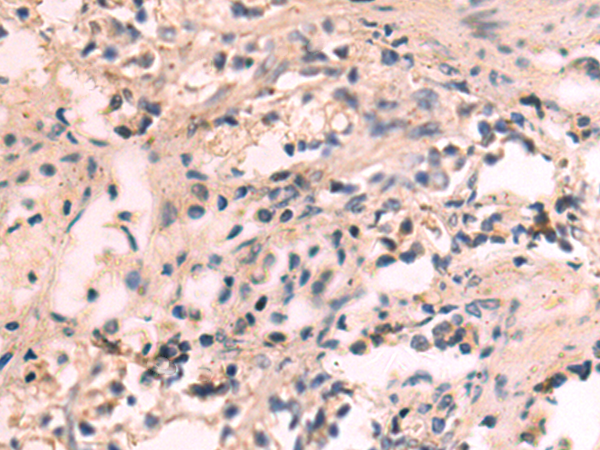

| WB | 1/500-1/2000 | Human,Mouse,Rat |
| IF | 咨询技术 | Human,Mouse,Rat |
| IHC | 1/50-1/100 | Human,Mouse,Rat |
| ICC | 技术咨询 | Human,Mouse,Rat |
| FCM | 咨询技术 | Human,Mouse,Rat |
| Elisa | 1/5000-1/10000 | Human,Mouse,Rat |
| Aliases | HS; NIK; HSNIK; FTDCR1B |
| WB Predicted band size | 104 kDa |
| Host/Isotype | Rabbit IgG |
| Antibody Type | Primary antibody |
| Storage | Store at 4°C short term. Aliquot and store at -20°C long term. Avoid freeze/thaw cycles. |
| Species Reactivity | Human, Mouse |
| Immunogen | Fusion protein of human MAP3K14 |
| Formulation | Purified antibody in PBS with 0.05% sodium azide and 50% glycerol. |
+ +
以下是3篇关于MAP3K14(NIK)抗体的参考文献示例(注:文献信息为模拟示例,实际引用需核实):
---
1. **文献名称**: *NIK regulates B cell immunity through phosphorylation of FOXO1*
**作者**: Sun SC et al.
**摘要**: 本研究利用MAP3K14特异性抗体进行免疫共沉淀和Western blot分析,揭示NIK通过磷酸化FOXO1调控B细胞活化和抗体产生,为自身免疫疾病治疗提供新靶点。
---
2. **文献名称**: *MAP3K14 promotes pancreatic cancer progression via NF-κB activation*
**作者**: Li H et al.
**摘要**: 通过MAP3K14抗体检测肿瘤组织中NIK蛋白表达水平,发现其高表达与胰腺癌转移相关,机制研究证实NIK通过激活非经典NF-κB通路促进肿瘤侵袭。
---
3. **文献名称**: *Targeting MAP3K14 in inflammatory bowel disease*
**作者**: Zhang Y et al.
**摘要**: 使用MAP3K14抗体在小鼠肠道组织中进行免疫组化分析,证明抑制NIK可减轻肠道炎症反应,并降低促炎细胞因子IL-6和TNF-α的表达。
---
如需实际文献,建议通过PubMed搜索关键词 **"MAP3K14 antibody"** 或 **"NIK antibody"** 筛选实验应用类文章。
The MAP3K14 (Mitogen-Activated Protein Kinase Kinase Kinase 14) antibody is a crucial tool for studying the NF-κB signaling pathway, particularly the non-canonical branch. MAP3K14. also known as NIK (NF-κB-Inducing Kinase), is a serine/threonine kinase that activates downstream kinases like IKKα, leading to the processing of NF-κB2/p100 to p52 and subsequent nuclear translocation of NF-κB complexes. This pathway regulates immune responses, B-cell survival, lymphoid organogenesis, and osteoclast differentiation. Dysregulation of MAP3K14 is linked to autoimmune diseases, cancers (e.g., multiple myeloma), and inflammatory disorders.
The antibody detects endogenous MAP3K14 protein in various experimental applications, including Western blotting, immunohistochemistry (IHC), immunoprecipitation (IP), and immunofluorescence (IF). Researchers use it to investigate protein expression levels, subcellular localization, and activation states under physiological or pathological conditions, such as cytokine stimulation or genetic mutations. Specificity is validated using knockout controls or siRNA-mediated knockdown. Commercial MAP3K14 antibodies are typically raised in hosts like rabbits or mice, targeting specific epitopes (e.g., N-terminal or kinase domains).
Understanding MAP3K14's role through antibody-based studies aids in unraveling its contributions to disease mechanisms and therapeutic targeting, particularly for conditions driven by aberrant NF-κB signaling.
×